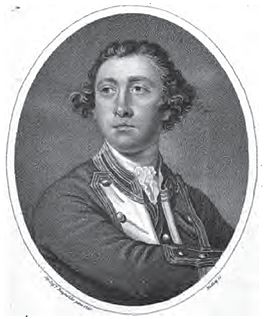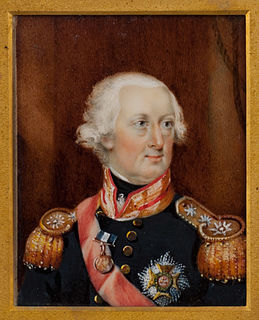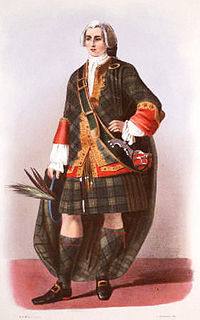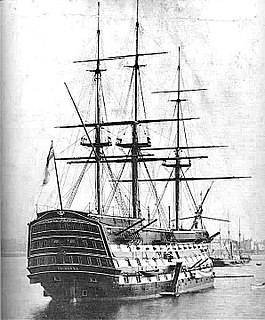
The Battle of Quiberon Bay, was a decisive naval engagement fought on 20 November 1759 during the Seven Years' War between the Royal Navy and the French Navy. It was fought in Quiberon Bay, off the coast of France near St. Nazaire. The battle was the culmination of British efforts to eliminate French naval superiority, which could have given the French the ability to carry out their planned invasion of Great Britain. A British fleet of 24 ships of the line under Sir Edward Hawke tracked down and engaged a French fleet of 21 ships of the line under Marshal de Conflans. After hard fighting, the British fleet sank or ran aground six French ships, captured one and scattered the rest, giving the Royal Navy one of its greatest victories, and ending the threat of French invasion for good.

Sir John Lockhart-Ross, 6th Baronet, known as John Lockhart from 1721 to 1760, was an officer of the Royal Navy who saw service during the War of the Austrian Succession, Seven Years' War, and the American War of Independence, and served for a time as a Member of Parliament.

Sir John Thomas Duckworth, 1st Baronet, GCB was an officer of the Royal Navy, serving during the Seven Years' War, the American War of Independence, the French Revolutionary and Napoleonic Wars, as the Governor of Newfoundland during the War of 1812, and a member of the British House of Commons during his semi-retirement. Duckworth, a vicar's son, achieved much in a naval career that began at the age of 11.
Admiral William Hotham, 1st Baron Hotham (1736–1813) was an officer in the Royal Navy. He was the son of Sir Beaumont Hotham, a lineal descendant of Sir John Hotham.

Admiral Sir Richard Goodwin Keats was a British naval officer who fought throughout the American Revolution, French Revolutionary War and Napoleonic War. He retired in 1812 due to ill health and was made Commodore-Governor of Newfoundland from 1813 to 1816. In 1821 he was made Governor of Greenwich Hospital in Greenwich, London. Keats held the post until his death at Greenwich in 1834. Keats is remembered as a capable and well respected officer. His actions at the Battle of Algeciras Bay became legendary.
Rear-Admiral Sir Richard Bickerton, 1st Baronet was a British naval officer who finished his career as a rear admiral in the Royal Navy and was ennobled as the first Baronet Bickerton of Upwood. He served in several naval engagements, and died Commander-in-Chief, Plymouth in 1792. His son Richard Hussey Bickerton, who likewise rose to flag rank in the Royal Navy, succeeded to the baronetcy following his death.
Francis William Drake was an officer of the Royal Navy. He served during the War of the Austrian Succession, the Seven Years' War and the American War of Independence, rising to the rank of vice-admiral of the red.
John Elliot was a Scottish officer of the Royal Navy who served during the Seven Years' War and the American War of Independence. He rose to the rank of Admiral, and served briefly as colonial governor of Newfoundland.

Robert Duff was an officer of the Royal Navy during the War of the Austrian Succession, the Seven Years' War and the American War of Independence. He rose to the rank of Admiral, and served briefly as colonial governor of Newfoundland.

George Edgcumbe, 1st Earl of Mount Edgcumbe, PC was a British peer, naval officer and politician.

Vice-Admiral Sir Joshua Rowley, 1st Baronet (1734–1790) was the fourth son of Admiral Sir William Rowley. Sir Joshua was from an ancient English family, originating in Staffordshire (England) and was born on 1 May 1734 in Dublin Rowley served with distinction in a number of battles throughout his career and was highly praised by his contemporaries. Unfortunately whilst his career was often active he did not have the opportunity to command any significant engagements and always followed rather than led. His achievements have therefore been eclipsed by his contemporaries such as Keppel, Hawke, Howe and Rodney. Rowley however remains one of the stalwart commanders of the wooden walls that kept Britain safe for so long.

William Locker was an officer in the Royal Navy, who served with distinction during the eighteenth century. He rose to the rank of captain and held the posts of flag captain and commodore.

Sir John Moore, 1st Baronet, KB was a British officer of the Royal Navy during the War of the Austrian Succession and the Seven Years' War. He eventually rose to the rank of admiral.
HMS Burford was a 70-gun third rate ship of the line of the Royal Navy, built at Chatham Dockyard to the draught specified by the 1745 Establishment as amended in 1754, and launched in 1757.

Sir Francis Geary, 1st Baronet was an officer of the Royal Navy. He served during the War of the Austrian Succession, the Seven Years' War, and the American War of Independence, eventually rising to the rank of Admiral.

Sir Charles Henry Knowles, 2nd Baronet, GCB was an officer of the Royal Navy, who saw service during the American War of Independence, and the French Revolutionary and Napoleonic Wars, eventually rising to the rank of Admiral. Highly intellectual, he authored a number of signal books and had the chance to put his ideas into practice during his naval career. Knowles was at times beset by problems with discipline aboard his ships, often due to large proportions of raw recruits and untrained seamen. This may have been a factor in his rocky relationship with his superior, Sir John Jervis, which eventually led to Knowles's retirement from active service after the Battle of Cape St Vincent, and his concentration on scholarly studies of the issues affecting the naval service.
Sir Francis Samuel Drake, 1st Baronet was an officer of the Royal Navy. He served during the Seven Years' War and the American War of Independence, rising to the rank of Rear-admiral of the Red.
Sir Henry Heathcote was an officer of the Royal Navy who served during the French Revolutionary and Napoleonic Wars.

Sir Charles Saxton, 1st Baronet was an officer of the Royal Navy who saw service during the War of the Austrian Succession, the Seven Years' War, the American War of Independence and the French Revolutionary and Napoleonic Wars, rising to the rank of captain.






















